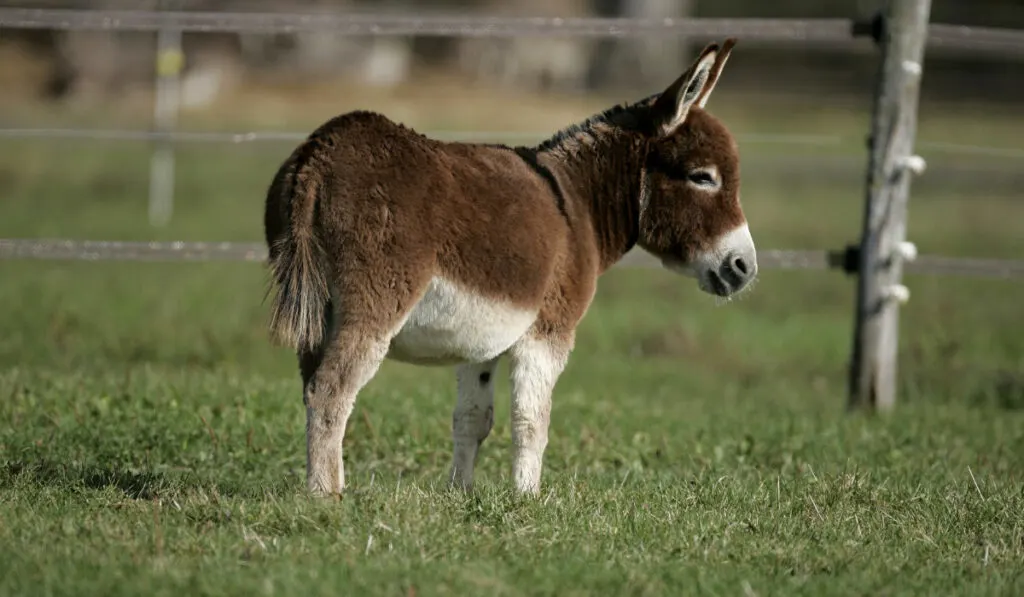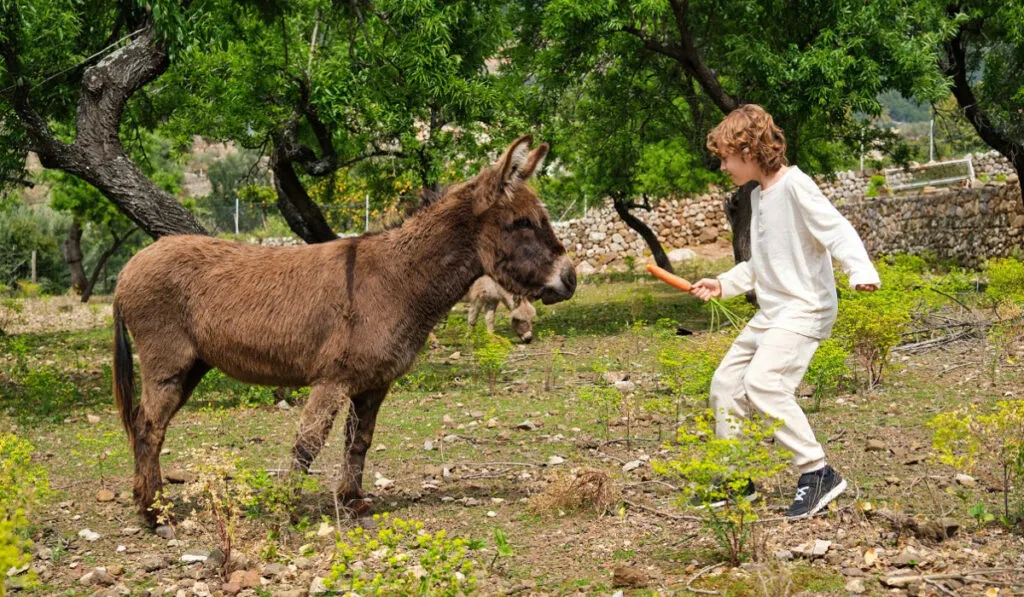Donkeys first arrived in North America with Columbus and the rest of the Spanish and Portuguese conquistadors. As useful pack animals, they quickly “burro’d” their way into the hearts and minds of the early settlers, and continue to charm their owners today. Here is a list of 11 donkey breeds commonly found in America – and beyond.
Table of Contents
Standard Donkey

Height: 36” – 48”, Large Standard 48” – 54” for jennets or 56” for jacks
Technically, donkeys in the US are grouped by size and type – not breed. In America, donkeys are mostly used as companion animals or to produce mules. America contains less than 1% of the world’s total donkey population of around 400 million.
Because of this, a North American donkey may look very much like a specific European rare breed (such as a Catalonian, Majorcan, or Andalusian) but is still classified by height unless he has a proven pedigree.
There are very few donkey registries in the US that track pedigrees (like there are with horses or dogs), so it can be difficult to tell exactly what sort of breed a donkey is. And, it’s often a pointless endeavor anyway – a donkey’s pedigree doesn’t prove his worth! (source)
Standard donkeys can come in any color, but they’re commonly gray-dun, brown, black, and sorrel. Many of them have a characteristic dorsal stripe, or “cross”, and very long ears.
Strong and hardy creatures, donkeys can survive in harsh conditions with poor quality food and little water for up to 25-25 years. Standard sized donkeys are used as pack animals, mounts for young children, or they can even be trained to pull a cart, or herd sheep!
Miniature Donkey

Height: Maximum 36”, average 32” – 34”
Miniature donkeys are cute, cuddly, and make wonderful companion animals. Originally from the Mediterranean area of North Africa and Italy, these hardy little creatures are popular pets in the United States.
More than 50,000 miniature donkeys are registered with the Miniature Donkey Registry.
Miniature donkeys are predominantly gray-dun in color (but may also be grey, brown, black, sorrel, white, or spotted), and feature the dorsal stripe “cross” marking on their backs.
Don’t let the name fool you though – miniature donkeys can still reach 200-350 pounds! Miniature donkeys can often be ridden by small children, or trained to pull carts.
American Mammoth Jackstock

Height: Above 48”
The roots of the American Mammoth Jackstock trace back to George Washington. In 1785, the King of Spain gifted George Washington with an Andalusian jack and two jennets.
Breeders were looking to produce large, strong mules and refine the current donkey stock. Large, good quality donkeys produce large, good quality mules.
The American Mammoth Jackstock is a blend of Catalonian, Andalusian, and Majorcan breeds from Spain. They are often black in color, as the original breed registry only accepted black individuals. (source)
Today, they are often used to produce high-quality mules, but may also be ridden under saddle or trained to pull carts. A mammoth donkey is an excellent choice for a novice rider who wants to take a leisurely trail ride – as long as he’s willing to do it the donkey’s way.
Wild Burro

Height: Any. Average around 44”
Free-roaming wild horses have been a landmark of the American West since they arrived in the Americas in the 1500s. But did you know that there are also herds of wild burros as well? Protected by the Wild Free-Roaming Horses and Burros Act of 1971. According to the BLM, around 16,000 feral donkeys roam public lands. (source)
These donkeys are mostly found in California, Arizona and Nevada. They are descendants of pack animals used in the mines during the gold rush of the 1800s. They have adapted to the harsh desert environment, surviving on poor forage and little water.
The Bureau of Land Management is responsible for maintaining acceptable herd levels of burros. Every year, they round up excess wild horses and burros and adopt them out to new approved homes.
Spotted Donkeys

While colorful donkeys aren’t technically a breed, spotted donkeys have unique coloring that makes them stand out from the sea of gray and black braying equines.
Spotted donkeys may have large irregular patches of white hair on their bodies, or they may appear to be light-colored with a splattering of dark spots.
Even though these donkeys might look like pinto horses or Appaloosas, their spots aren’t controlled by the same genes. Spotted donkeys have one copy of the dominant spotted gene, and one for non-spotted. This means that their offspring are not guaranteed to be spotted. (source)
You can usually find “spotted donkey” as a separate category on sales websites like EquineNow.com.
Rare Imported European Breeds of Donkey
Most of these donkeys were important for the development of the larger mammoth donkeys, but they are distinctive breeds with unique characteristics. They were imported in large quantities in the 19th century, and we can still see some of their features in modern donkeys today.
Catalonian
Origin: Catalonia (a region of northeast Spain and southwest France)
Height: 14.5 – 15 hands
Characteristics: These elegant donkeys added style and flair to the coarse American donkey. “Prized for their glossy coats ranging in color from black to brown, the Catalonian was said to be “less in size (14-1/2 to 15 hands), bone and foot but with the finest long, keen, Roman heads, and thin folding, upright ears”.
While there are few remaining Catalan donkeys in the world, members of this ancient breed still exist in Spain and France.
Majorcan
Origin: Mallorca (the largest island in the Balearic islands of Spain)
Other names: Balearic donkey, Catalan
Height: 15.5 hands
Characteristics: These large-boned donkeys were highly prized in their native homeland of Mallorca. They are usually black with characteristic white muzzles and white rings around the eyes.
They were exported in great numbers to England and the US in the early 20th century. So much so, that the breed almost became extinct.
Majorcan donkeys are tall – the largest breed of any that were imported to the US. They were bulky and heavy, which is good for producing solidly built strong mules, but they lacked the grace and refinement of the sleeker Catalonian donkeys. Today, there are only around 500 Majorcan donkeys left in the world.
Andalusian
Origin: Andalucia region, Spain
Height: 14-15.5 hands
Characteristics: These Spanish donkeys were some of the first to travel to the New World aboard conquistador ships. King Charles III sent some prized Andalusian donkeys to George Washington, and this secured their place as an important influence on American donkey breeding.
Andalusian donkeys are usually gray, which eventually made them unpopular for creating Mammoth jacks (as black was the preferred color). They are known for being one of the oldest donkey breeds in Europe, but there are less than 1,000 of them left today.
Maltese
Origin: Malta (off the coast of Sicily)
Height: under 14 hands
Characteristics: A small, fiery breed, the Maltese was one of the first donkey breeds to arrive in the Americas. They were usually black or brown, with attractive heads and ears.
While the Maltese donkey originally produced mules for the United States, breeders stopped using them in favor of other European breeds, due to their smaller size and poor quality. Only about 50 estimated Maltese donkeys exist today.
Poitou of France
Origin: France
Height: 14.5 – 15 hands
Characteristics: These large donkeys have been used to produce fine mules since the middle ages. They have large heads, large leg joints, and big floppy ears. Their most distinctive feature is the long shaggy coat – which is often deliberately left ungroomed.
The long, shaggy hair can form cadenettes –a French hairstyle that resembles dreadlocks. Currently, there are less than 100 Baudet donkeys left in the world.
African Wild Ass
Origin: Africa (small areas of the Eastern part of the continent, from Egypt to Somalia)
Height: 12 – 14 hands
Characteristics: These wild donkeys are the predecessors of today’s modern domesticated equine breeds. They are light gray in color, and feature a primitive dorsal dsdstripe and horizontal zebra-like stripes on the legs. They live together in small herds in the African desert, and can run quickly through the mountainous arid terrain – up to 40 mph!

Final Thoughts
In general, donkeys make wonderful companions. Whether your horse is feeling a little lonely in his pasture, or you need a bomb-proof (albeit perhaps a little stubborn) trail mount on the weekends, a donkey might be a perfect choice.
As with adding any pet to your menagerie, make sure to do the proper research. Donkeys are often labeled difficult to train because they don’t react the same way to training as a horse would. That means that if you haven’t trained a donkey before, you will need to be willing to learn and a trusting relationship takes time to build. But, if you put in the time and effort, a donkey can be a valuable asset for any equine enthusiast!
Resources:
- http://www.nmdaasset.com/

